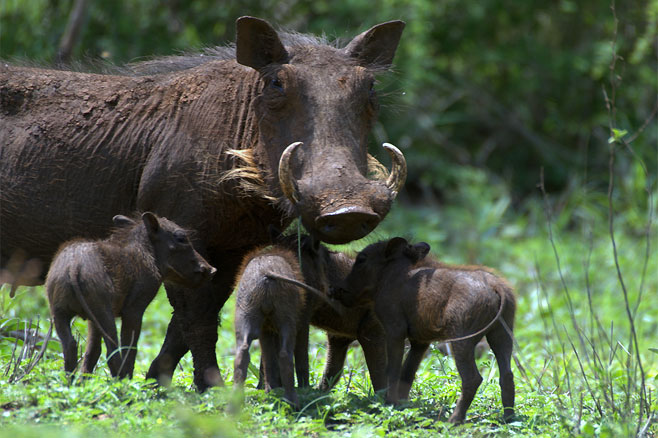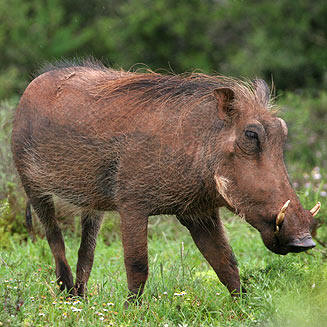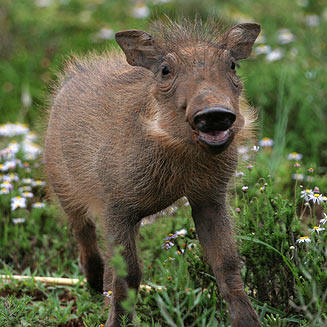|
Phacochoerus africanus (Common warthog)
warthog [English]; vlakvark [Afrikaans]; Warzenschwein [German]; phacochere [French]; ngiri, mbango
[Swahili]; indayikaz:me, ingulube yesiganga [isiNdebele]; ingulube [isiXhosa]; indlovudawana, intibane [isiZulu]; kolobe, kolobe-moru, mokhesi, mokgesi
[Sesotho]; kolobÍ [Sepedi] [Setswana] [Lozi]; njiri [Shona]; budzayikatana
[siSwati]; ngulube, nguluve, ndaekedzane [Xitsonga]; phangwa [Tshivenda]; ungili [Yei]; Dirib, gairib [Nama] [Damara]; mbinda [Herero]
Life
>
Eukaryotes >
Opisthokonta >
Metazoa (animals) > Bilateria > Deuterostomia >
Chordata > Craniata > Vertebrata (vertebrates) >
Gnathostomata (jawed vertebrates) > Teleostomi (teleost
fish) > Osteichthyes (bony fish) > Class:
Sarcopterygii (lobe-finned fish) > Stegocephalia
(terrestrial vertebrates) > Reptiliomorpha > Amniota >
Synapsida (mammal-like reptiles) > Therapsida > Theriodontia
> Cynodontia > Mammalia (mammals)
> Placentalia (placental mammals) >
Laurasiatheria > Ferungulata > Cetartiodactyla (even-toed ungulates and cetaceans)
> Suiformes (pigs) > Family: Suidae >
Subfamily: Phacochoerinae
 |
|
Warthog family, Kruger National Park, South Africa. [photo Arno Meintjes
©] |
 |
 |
|
Warthog, Addo National Park. [photo Duncan Robertson
©] |
Baby warthog, Addo National Park. [photo Duncan Robertson
©] |
Warthogs are a common site in African savannas in
protected areas where they have not been exterminated by people.
Groups (sounders) consist either of sows and their piglets or
bachelor groups. Warthogs are diurnal and graze mainly on short
grass but will also eat sedges, herbs, leaves from shrubs and wild
fruits. They also dig up and eat succulent rhizomes. They use
burrows as dens.
Identification
Warthogs have a pig-like appearance. The body
is grey and sparsely haired, except for a dorsal mane (yellowish
–brown to black) that lies along its back. When the warthog is
stressed the mane stands up. There are prominent wart-like
protuberances on the face, two pairs on the male and one on the
female. The canine teeth of the adults develop into curved tusks.
While the upper set are more impressive, the smaller lower tusks are
the main weapons. The males are larger than the sows with more
pronounced tusks and warts. Warthogs walk on the third and fourth
digits of each foot, while the smaller second and fifth digits are
usually clear of the ground. Their thin tail with a black tuft at
the end is held erect when they trot or are alarmed.
Size
Height at shoulder 60-70 cm; weight range 60 -
105kg (males) and 45 –70 kg (females).
Dental Formula
I C C P P M M =
32-34 =
32-34
Distribution and habitat
Open savanna grassland and light woodland in
sub-Saharan Africa.
General behaviour
Groups (or sounders) of warthogs usually
consist of a family group of sows and their piglets or bachelor
groups. Boars that are sexually active are usually solitary except
when with a sow. Warthogs use
aardvark and
porcupine
burrows as dens, but can dig their own burrows if necessary. They
use there forefeet and snouts for digging and then shovel the excess
sand out of the burrow with their snouts.
Food
Warthogs spend most of the day looking for
food. In addition to grazing they will root for succulent rhizomes.
Characteristically they will usually kneel while rooting in this
way.
Reproduction
The gestation period is about 170 days. Pregnant sow separate from the sounder and
farrow in a hole underground, the piglets remain in the nest for 2
weeks. The litter usually consists of 2 – 3 piglets but as many as 8
may be born. The piglets then follow their mother and they are weaned
at about 3 months. Young pigs will remain with their mother in a
tightly knit family group for about a year until she is ready to
farrow again.
Life span
12 –15 years
Conservation
Although warthogs are hunted they are not
regarded as threatened.
Text by Denise Hamerton |
